The Intel Haswell-E CPU Review: Core i7-5960X, i7-5930K and i7-5820K Tested
by Ian Cutress on August 29, 2014 12:00 PM ESTIntel Haswell-E Overclocking
One of the burgeoning questions relating to overclocking over the past couple of years has been the quality of Intel’s construction under the heatspreader relating to thermal interface material and adhesives. This caused enough of a talking point for Intel to release Devil’s Canyon (read our review here) which featured an upgraded interface and essentially reduced the thermal pressure restricting the overclock.
Thankfully Intel has not decided to play around with the extreme edition platform too much since Nehalem. Although recent reports suggest that Intel is using an epoxy to bind the die to the heatspreader, one tell-tale sign that a goopy TIM is not being used is the hole in the heatspreader in one of the corners.
Looking through the previous generations, Sandy-E, Ivy-E and Haswell-E shows this hole, which is typically thought to allow for expansion of the heatspreader and/or gas trapped inside due to the heat. Also due to the way that the epoxy is handled, the heatspreader cannot be removed without force and destroying parts the silicon die.
Due to the way that the CPU is arranged, with the cores to the left and right of center, there may develop a series of recommendations when using different methods of applying thermal paste as the sources of the heat will most likely be in these two regions. I would advise the normal procedure of applying thermal paste here: a small blob in the middle and allow the heatsink to spread the TIM through applied pressure. This helps remove air bubbles as the TIM spreads; spreading it out manually leads to air bubbles all over the place and is not recommended for high thermal sources.
In our results below we are using a Cooler Master Nepton 140XL closed loop liquid CPU cooler, and following the instructions above our CPU temperatures stay extremely low until we pile on the overclock. In fact I was seeing less than 30ºC while idle, which should bode well for overclocking.
Methodology
Our standard overclocking methodology is as follows. We select the overclock options and test for stability with PovRay and OCCT to simulate high-end workloads. These stability tests aim to catch any immediate causes for memory or CPU errors.
For manual overclocks, based on the information gathered from stock testing, we start at a nominal voltage and CPU multiplier, and the multiplier is increased until the stability tests are failed. The CPU voltage is increased gradually until the stability tests are passed, and the process repeated until the motherboard reduces the multiplier automatically (due to safety protocol) or the CPU temperature reaches a stupidly high level (100ºC+). Our test bed is not in a case, which should push overclocks higher with fresher (cooler) air.
Results
Due to the timing of our testing, we were only able to test two i7-5960X CPUs. Both of these were M0 stepping samples, the same as the retail stepping as far as we understand. The i7-5960X for reference is a 3.0 GHz base clock CPU with 8 cores, with a stock load voltage around 1.050 volts. Standard turbo modes allow 3.5 GHz, and so we start our testing at 3.5 GHz on all cores at 1.000 volts set in the BIOS. Where load line calibration was possible, it was enabled to match our setting as closely as possible, but otherwise only the CPU voltage was adjusted.
The first sample has a lot of early headroom with +0.100 volts allowing for an extra +1.1 GHz, or a 36.7% overclock. It has been a long while since numbers like +36.7% has been bandied around Intel’s extreme range, with only the i7-920 type Nehalem CPUs doing that sort of overclock in its stride.
The sweet spot for this CPU seems to be at around 4.4 GHz where the CPU voltage is just starting to rise but peak temperatures are under 75ºC.
Unfortunately our second sample was pretty much a dud by comparison. The voltage needed early on in the overclock went up quickly. This time we were unable to monitor temperatures due to a BIOS issue, but had a power meter on hand. We still managed a +1.1 GHz overclock easily enough, although +0.175 volts was required.
At 4.1 GHz, peak power is +104W over the system power draw at stock, with another 40W at 4.3 GHz. This shows that Haswell-E can be a power hog from even small overclocks, and thus users must have cooling to match. If we add the 140W TDP and the +140W more from the overclock (it would most likely be more than this due to the change of efficiency in the PSU curve), then a mildly overclocked CPU is fast approaching 300W. One can imagine that a highly clocked 4.7 GHz sample would be nearer 400W, and thus users should purchase power supplies to match.
A Problem with Haswell
One issue from Haswell does crop up with Haswell-E: the variability in the quality of the processors. Intel only guarantees that the processor will run at the specific frequency and voltage that is applied out of the factory: any other speed is out of specification and not supported. With Haswell LGA1150 CPUs, while the turbo frequency of the i7-4770K was 3.9 GHz, some CPUs barely managed 4.2 GHz for a 24/7 system.
If we consider that the i7-4770K only needs one of those CPU cores to be below quality to ruin overclockability, then placing double the cores on the i7-5960X is asking for double the trouble. Time to put some numbers to this:
In ASUS’ press deck for overclocking recommendations that came with the X99-Deluxe, they tell us the following:
i7-5960X at 4.4 GHz with 1.300 volts is below average
i7-5960X at 4.5 GHz with 1.300 volts is average
i7-5960X at 4.6 GHz with 1.300 volts is above average
By that standard our first CPU is around average and the second CPU we tested is below average. Even with these guidelines, it would seem that other reviewers and even manufacturers are getting a wide array of results. I have heard of reports of CPUs getting 4.7 GHz on a water loop, whereas others are testing a range of CPUs and not getting more than 4.4 GHz, like our second sample.
ASUS is recommending that anything over 1.25 volts requires a water/liquid cooling as a bare minimum, with up to 1.35V needing a triple (3x120mm) radiator setup depending on ambient temperatures. As with most overclocked setups, this means that the enthusiast user must decide between clock speed or fan noise for their machine.
Another issue with Haswell-E is the current draw of the CPU. ASUS is stating that the standard current draw for the CPU can reach 25 amps, meaning that the power supply must be capable of supplying at least 30 amps on the EPS12V cable. This is covered for most home-build non-OEM power supplies with an 80 PLUS rating, but suggests that a cheap power supply might trigger the over-current protection early.
Comparison to Ivy Bridge-E, Sandy Bridge-E, Haswell
As part of our testing, we hooked up our older i7-4960X and i7-3960X to the ASUS Rampage IV Black Edition, as well as compared to our previous i7-4790K Haswell overclocks:
Our i7-3960X sample at the time was actually a really nice overclocking CPU, in comparison to our i7-4960X which was below overage. I put two values here for the i7-5960X, showing that a 4.3 GHz overclock, while it is lower in number than the 4.8 GHz of the i7-3960X, is actually around the same percentage overclock. If we have a good i7-5960X for comparison, then +50% overclock comes very easily.
The next question then is which one is better for performance? While the Haswell-E CPUs have a lower frequency than the previous generations, they do have the benefit of a higher IPC and DDR4 memory. There is also the core count, with the i7-5960X having 8 cores at 4.3/4.6 GHz against the six cores or four cores.
It should be obvious that for single core throughput, the i7-4790K wins at 4.7 GHz:
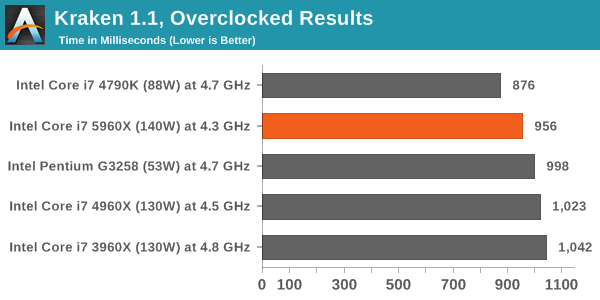
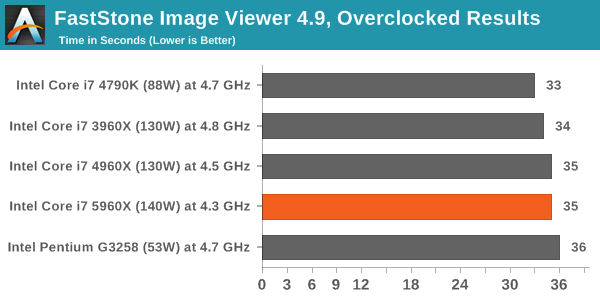
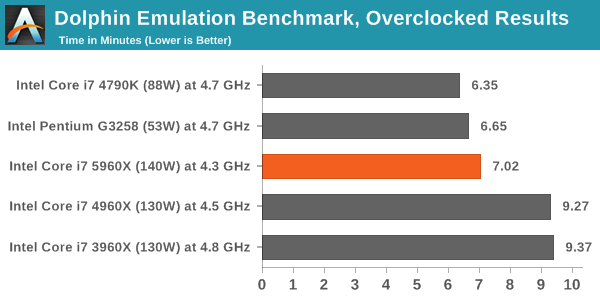
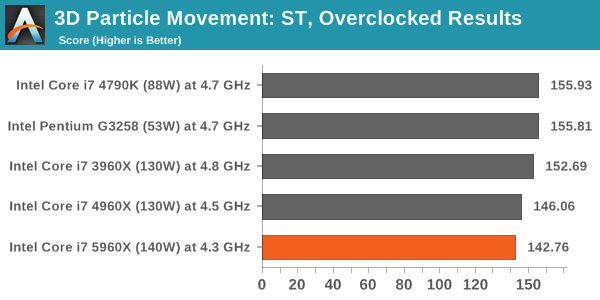
In most benchmarks, the 5960X, 4960X and 3960X are actually evenly matched for single threaded performance, with the 5960X taking the edge on software that can take advantage of the newer instruction sets.
For multithreaded tasks, an overclocked i7-5960X is the only way to go:
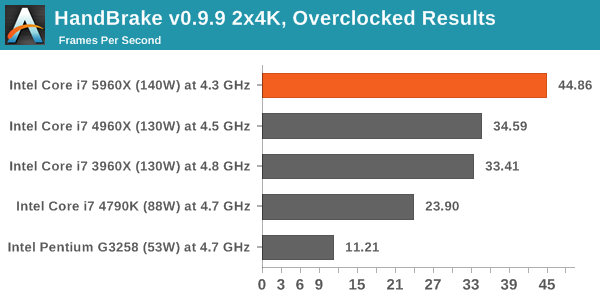
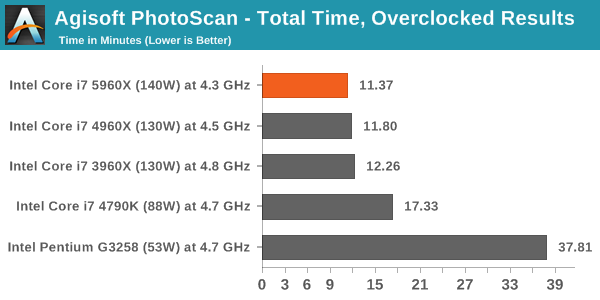
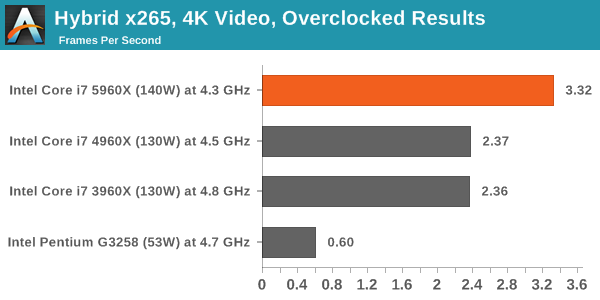
The graphs later in the review comparing each of these processors at stock will have our overclocked results as well.




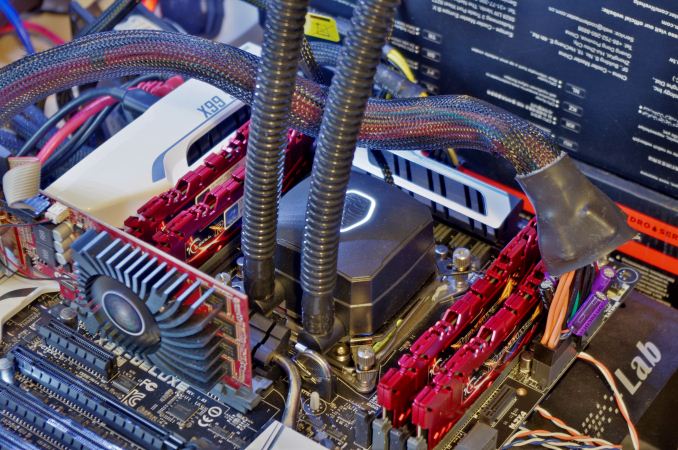
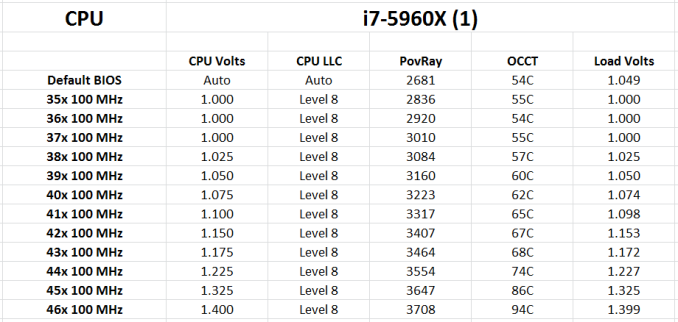
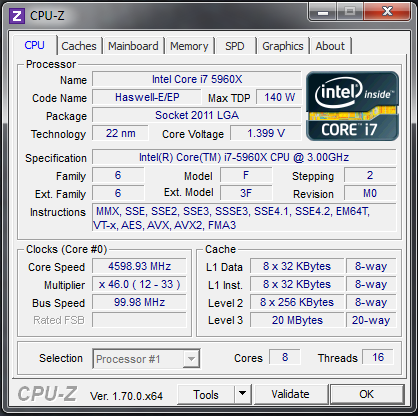
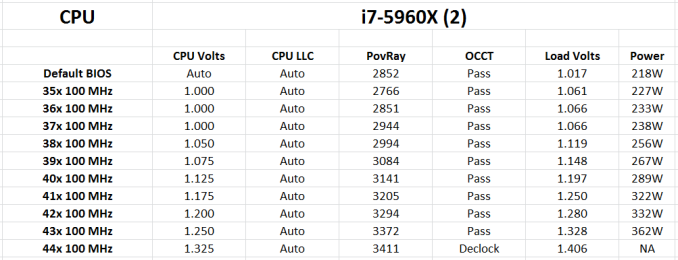










203 Comments
View All Comments
schmak01 - Friday, January 16, 2015 - link
I thought the same thing, but it probably depends on the game. I got the MSI XPower AC X99s Board with the 5930K. when I was running a 2500k at 4.5 Ghz for years. I play a lot of FFXIV which is DX9 and therefore CPU strapped. I noticed a marked improvement. Its a multithreaded game so that helps, but on my trusty sandy bridge I was always at 100% across all cores while playing, now its rarely above 15-20%. Areas where Ethernet traffic picks up, high population areas, show a much better improvement as I am not running out of CPU cycles. Lastly Turnbased games like GalCivIII and Civ5 on absurdly large Maps/AI's run much faster. Loading an old game on Civ5 where turns took 3-4 minutes now take a few seconds.There is also the fact that when Broadwell-E's are out in 2016 they will still use the LGA 2011-3 socket and X99 chipset, I figured it was a good time to upgrade for 'future proofing' my box for a while.
Flunk - Friday, August 29, 2014 - link
Right, for rendering, video encoding, server applications and only if there is no GPU-accelerated version for the task at hand. You have to admit that embarrassingly parallel workloads are both rare and quite often better off handed to the GPU.Also, you're neglecting overclocking. If you take that into account the lowest-end Haswell-E only has a 20%-30% advantage. Also, I'm not sure about you but I normally use Xeons for my servers.
Haswell-E has a point, but it's extremely niche and dare I say extremely overpriced? 8-core at $600 would be a little more palatable to me, especially with these low clocks and uninspiring single thread performance.
wireframed - Friday, August 29, 2014 - link
The 5960X is half the price of the equivalent Xeon. Sure if you're budget is unlimited, 1k or 2k per CPU doesn't matter, but how often is that realistic.For content creation, CPU performance is still very much relevant. GPU acceleration just isn't up to scratch in many areas. Too little RAM, not flexible enough. When you're waiting days or weeks for renderings, every bit counts.
CaedenV - Friday, August 29, 2014 - link
improvements are relative. For gaming... not so much. Most games still only use 4 core (or less!), and rely more on the clock rate and GPU rather than specific CPU technologies and advantages, so having a newer 8 core really does not bring much more to the table to most games compared to an older quad core... and those sandy bridge parts could OC to the moon, even my locked part hits 4.2GHz without throwing a fuss.Even for things like HD video editing, basic 3D content creation, etc. you are looking at minor improvements that are never going to be noticed by the end user. Move into 4K editing, and larger 3D work... then you see substantial improvements moving to these new chips... but then again you should probably be on a dual Xeon setup for those kinds of high-end workloads. These chips are for gamers with too much money (a class that I hope to join some day!), or professionals trying to pinch a few pennies... they simply are not practical in their benefits for either camp.
ArtShapiro - Friday, August 29, 2014 - link
Same here. I think the cost of operation is of concern in these days of escalating energy rates. I run the 2500K in a little Antec MITX case with something like a 150 or 160 watt inbuilt power supply. It idles in the low 20s, if I recall, meaning I can leave it on all day without California needing to build more nuclear power plants. I can only cringe at talk about 1500 watt power supplies.wireframed - Friday, August 29, 2014 - link
Performance per watt is what's important. If the CPU is twice as fast, and uses 60% more power! you still come out ahead. The idle draw is actually pretty good for the Haswell-E. It's only when you start overclocking it gets really crazy.DDR4's main selling point is reduced power draw, so that helps as well.
actionjksn - Saturday, August 30, 2014 - link
If you have a 1500 watt power supply, it doesn't mean you're actually using 1500 watts. It will only put out what the system demands at whatever workload you're putting on it at the time. If you replaced your system with one of these big new ones, your monthly bill might go up 5 to 8 dollars per month if you are a pretty heavy user, and you're really hammering that system frequently and hard. The only exception I can think of would be if you were mining Bit Coin 24/7 or something like that. Even then it would be your graphics cards that would be hitting you hard on the electric bill. It may be a little higher in California since you guys get overcharged for pretty much everything.Flashman024 - Friday, May 8, 2015 - link
Just out of curiosity, what do you pay for electricity? Because I pay less here than I did when I lived in IA. We're at .10 KWh to .16 KWh (Tier 3 based on 1000KWh+ usage). Heard these tired blanket statements before we moved, and were pleased to find out it's mostly BS.CaedenV - Friday, August 29, 2014 - link
Agreed, my little i7 2600 still keeps up just fine, and I am not really tempted to upgrade my system yet... maybe a new GPU, but the system itself is still just fine.Let's see some more focus on better single-thread performance, refine DDR4 support a bit more, give PCIe HDDs a chance to catch on, then I will look into upgrading. Still, this is the first real step forward on the CPU side that we have seen in a good long time, and I am really excited to finally see some Intel consumer 8 core parts hit the market.
twtech - Friday, August 29, 2014 - link
The overclocking results are definitely a positive relative to the last generation, but really the pull-the-trigger point for me would have been the 5930K coming with 8 cores.It looks like I'll be waiting another generation as well. I'm currently running an OCed 3930K, and given the cost of this platform, the performance increase for the cost just doesn't justify the upgrade.